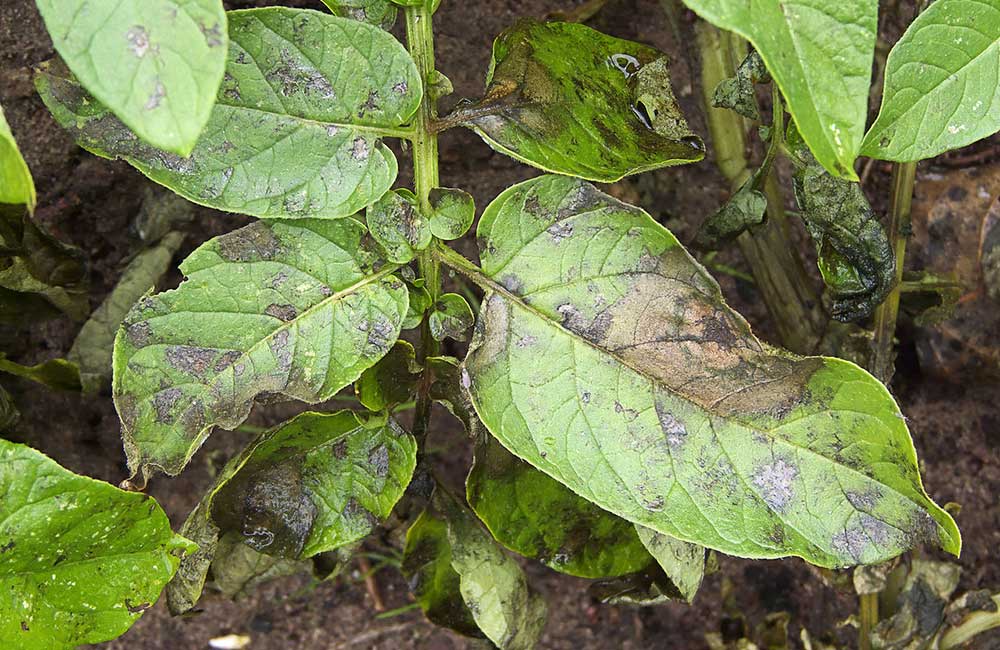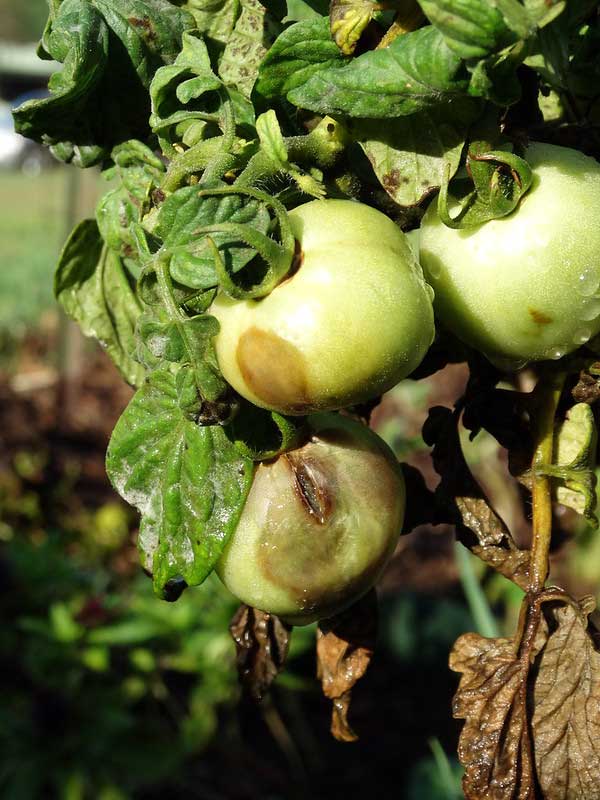Late blight is a disease of tomatoes and potatoes caused by several strains of Phytophthora infestans, a species of oomycete (also known as ‘water molds’), which are similar to fungi. Late blight first appears in the form of water-soaked spots, which spread to stems, fruits, and tubers, and can eventually result in the death of the plant. Late blight is a devastating disease, best known for its role in the Irish potato famine of the 1840s.
Late blight causes water-soaked spots, which may be brown, grayish green, or blackish in color.
Contrary to other diseases, these spots are not delimited by leaf veins, as is the case with diseases like angular leaf spot. These spots often start out small, but rapidly expand, quickly darkening, withering and killing entire leaves. In humid conditions, these spots will produce white fungal growths, which produce the spores that spread the disease.

In tomatoes, the disease readily spreads to stems and fruit. Fruit infected by late blight develop large, dark-colored lesions which may cover much of the surface. This fruit often succumbs to rot, sometimes disintegrating entirely.
Potato plants exhibit similar symptomology. When tubers are infected, the skin takes on a coppery, brownish, or purplish coloration, with dark depressions sometimes appearing. The internal tissue under the skin may rot to a depth of ½” or so, taking on a reddish-brown color. If infected potatoes are unknowingly harvested and stored, they may sprout sporulating fungal bodies after the fact, resulting in the infection of adjacent, uninfected potatoes.
Late blight can be a tremendously destructive disease. If left unchecked, entire fields of plants can be destroyed in weeks. In windy or rainy conditions, the disease can also spread to other fields, quickly infecting many plants.

Phytophthora infestans, the fungus-like organism which causes late blight, requires a living host to overwinter.
While many of the pathogens which plague various crop species can overwinter in infected plant debris or soil, P. infestans is a relatively fragile organism. It can only survive for very short periods without a living host. Consequently, the pathogen tends to infect crops in subsequent seasons by overwintering in tubers and fruits left behind in the soil.
With potatoes in particular, growers should be very careful about discarding culls if plants may be infected with late blight. All potentially infected culls should be removed from the field entirely and crushed, frozen, composted or buried no less than 2 feet deep.
The spores of P. infestans can be spread by water or air, and infection usually occurs when spores are carried via air over long distancea from adjoining infected fields, or over short distances from volunteer plants sprouted from dropped tomato fruits or discarded tubers from the previous season.
While the pathogen can reproduce and spread in temperatures ranging from above freezing to nearly 80 degrees, it particularly favors temperatures of 64 to 72 degrees Fahrenheit. At these temperatures, the pathogen can spread by air and easily infect entire fields in a matter of days. In cooler temperatures, P. infestans spreads via zoospores, spores which can move on their own, but which require water to do so—this slows their travel and diminishes their range, which means that transmission only occurs between adjacent plants.
The most effective means of managing late blight is careful sanitation, to prevent spreading the disease from one year’s crop to the next.
There are a variety of targeted, broad spectrum, and copper-based fungicides which are effective in controlling the disease when it occurs. However, this is costly, and chemical-based interventions are most effective when used in a preventative fashion. Mild infections can be managed with regular applications of foliar fungicides, but more entrenched infections are incurable.
To protect against the spread of the disease, sanitary practices must be implemented. If the presence of the disease is suspected, fields should be regularly inspected. If only a few plants are infected, these plants should be disked under and buried, or killed with herbicide. Adjacent healthy plants should also be destroyed, as they likely harbor the disease but are not yet symptomatic.
In between plantings, all plant debris must be removed from fields. Culls and any other remaining debris must be buried at least 2 feet deep to prevent reoccurrence of disease.
Lastly, growers should be careful to monitor for and remove wild nightshade plants, such as hairy nightshade, as these can harbor and retransmit the disease between plantings.




